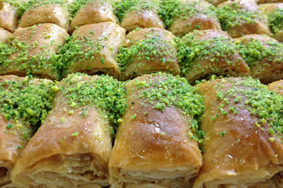
What is Baklava?
It is the first and most authentic type of Mediterranean sweets. It it embraces 140 years of passion into each single piece. The finest pistachios are roasted to perfection and sandwiched between fine layers of our great grandfather›s secret recipe of dough and baked with care and affection.Baklava with pistachios filling
Ingredients
Wheat flour, wheat starch, pistachios, pine nuts, cashews, walnuts, sugar, flour, butter, butter ghee, corn oil, salt.
Characteristics
Original Baklava is the most popular among all Mediterranean sweets.
It features a thick layer of nuts such as pistachios, pine nuts, cashews, or walnuts. The thicker its nuts filling, the richer and the tastier it is.
One of its secrets is the amount of sugar syrup to add to it. The right amount will give it a sweet taste while keeping the taste of nuts and dough in perspective. Adding too much sugar syrup would dominate its taste and hide the satisfaction delivered by the nuts dough, while being too short on the sugar syrup would deny its its sweet feeling and gratification.
How is Baklava Made?
The thin dough and the sugar syrup are first prepared. Then Baklava cubes consisting of raw nuts sandwiched between multi-layered dough are prepared and baked.
Preparation of the Dough
The dough closely resembles phyllo dough, but it is substantially thinner than commonly found phyllo dough. To make the dough, flour, water, and a hint of salt are mixed together. Then the dough is cut into small balls, and each ball is kneaded extensively to form a very thin layer of dough.
Preparation of Sugar Syrup
To prepare sugar syrup, generous amounts of sugar are added to water and heated at very high temperature to dissolve the sugar in the water. The mix is brought to a boiling point after which a hint of lemon is added and the resulting sugar syrup is then left to cool.
with pine nuts and cashews filling
Preparation of Baklava
About nine layers of the paper thin dough are stacked on top of each other. While stacking, starch is added between each two layers of dough. In order to make sure the stack of layered dough stays very thin, each time a layer is added, the whole stack is kneaded anew.
Next, the filling consisting of raw nuts with a hint of sugar is added on top of the dough. Pistachios, walnuts, and blends of pine kernels and cashews are usually used as filling.
Afterwards, another stack of nine layers of thin dough is prepared and placed on top of the nuts resulting in a thick layer of nuts sandwiched between two layers of dough.
Finally, the nuts filled dough is cut into cubes of the desired size.
Baking
The Baklava cubes are placed on a baking sheet, and hot melted butter ghee is poured on top. They are then baked for about one hour on medium temperature. After baking, the remaining butter ghee is drained and sugar syrup is added on top.
Gifting Baklava
Mediterranean pastries, besides being great desserts, they also constitute great gifts on many occasions.
Lunch or Dinner Party Gift
Whether you are invited to a lunch or dinner party, or whether you are gathering with friends for a celebration, taking with you an arrangement of Baklava is greatly appreciated. This great Mediterranean pastry provides instant gratification and satisfies anybody with a sweet tooth. It is gifted on virtually every occasion. It is a great gift to your teacher on Teacher›s day as well as to a friend as a Thank You gesture.
Holiday Gift
On holidays, all over the world, this sweet treat is becoming the natural gift. In the Middle East, it is hardly possible for a holiday to pass and not to gift or to receive a gift of Mediterranean pastries.
with walnuts filling
Serving Suggestions
Mediterreanean pastries are served as dessert. It can be served alone or as part of an arrangement of Mediterranean sweets which also includes Borma, Basma, Ballorieh, Fingers, Kol Weshkor (Roses), and other Mediterranean sweets.
Popularity
Mediterranean pastries have recently gained worldwide popularity, but their stronghold stays in Mediterranean and Middle Eastern countries such as Lebanon, Syria, Jordan, Palestine, and Egypt as well as in Turkey, Serbia, Armenia, Iran, Greece, Pakistan, and the Arabic Gulf region.
Among all Mediterranean pastries, it has the most widespread reach and popularity.
Classification
It is an authentic Mediterranean pastry and is one of the most famous desserts of the region.
In the Middle East, it is considered one of the elements that constitute the assorted Baklava family which comprises many other Middle Eastern pastries.
 Mahroum Sweets From Nazareth
Mahroum Sweets From Nazareth